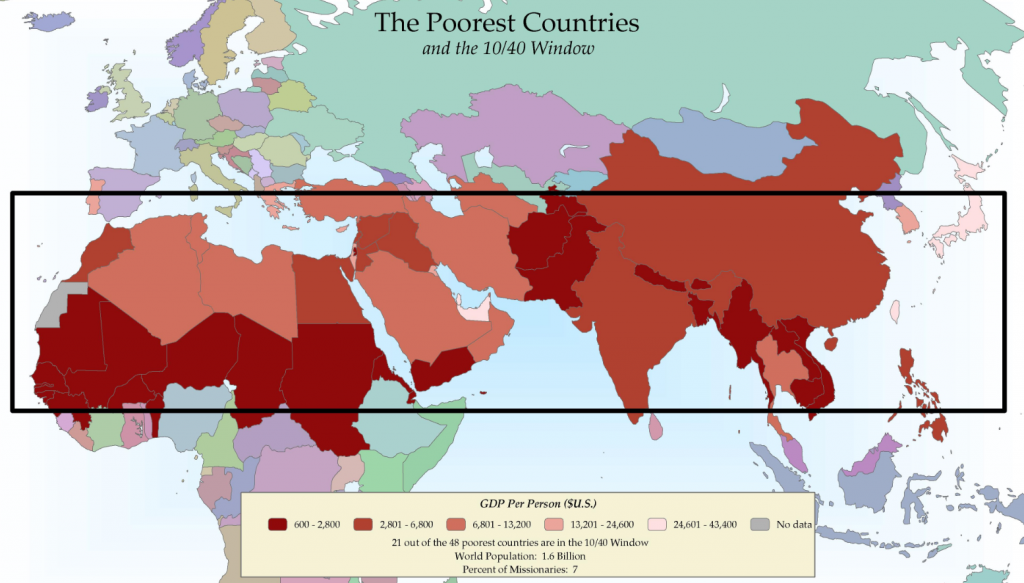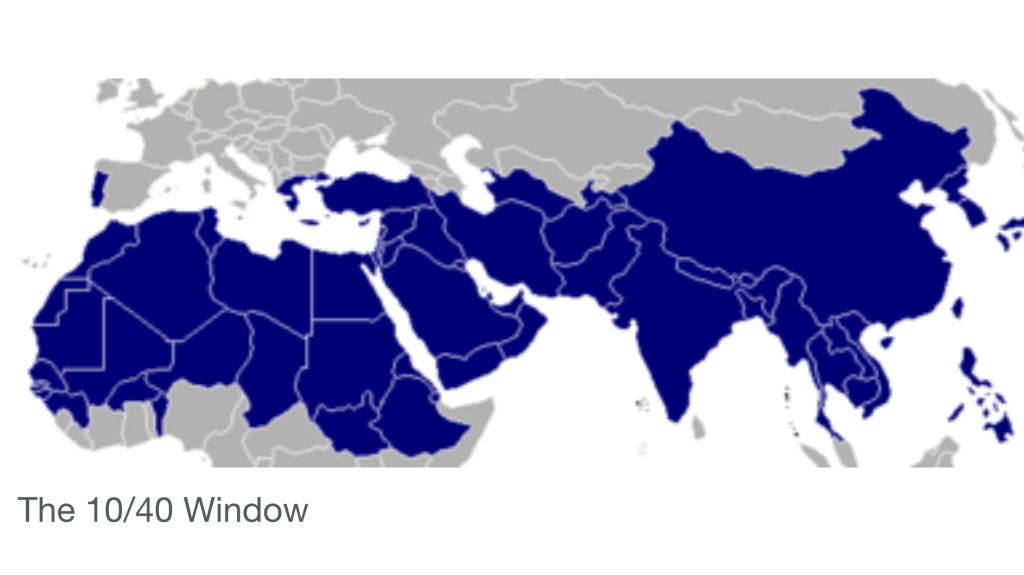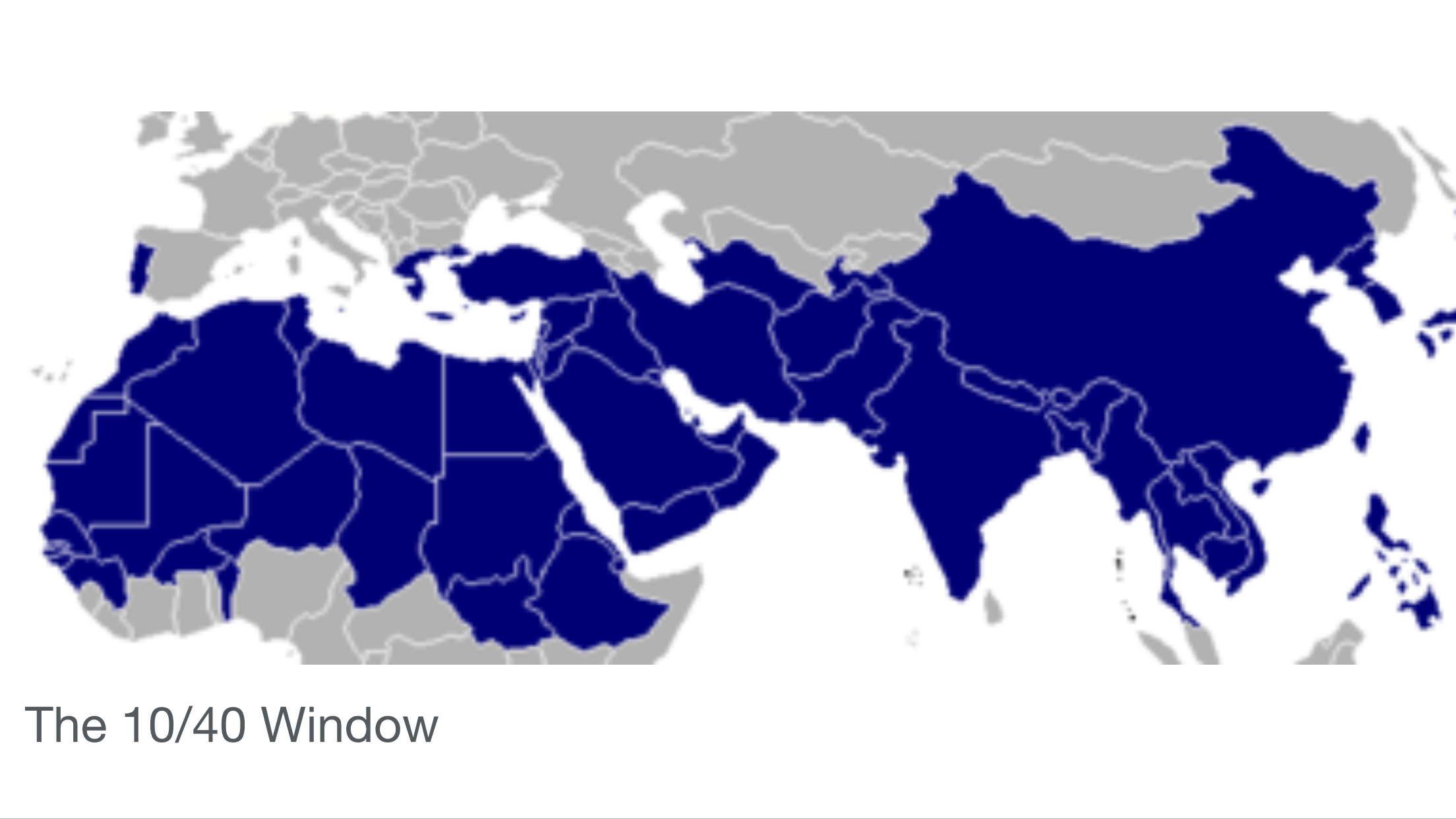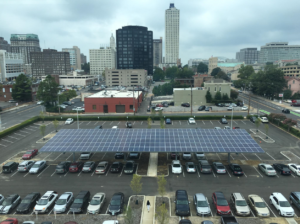
The 10/40 Window is a term coined by Christian missionary strategist and Partners International CEO Luis Bush in 1990[1] to refer to those regions of the eastern hemisphere, plus the European and African part of the western hemisphere, located between 10 and 40 degrees north of the equator, a general area that was purported to have the highest level of socioeconomic challenges and least access to the Christian message and Christian resources on the planet.
The concept behind the 10/40 Window highlights these three elements (as of data available in 1990): an area of the world with great poverty and low quality of life, combined with lack of access to Christian resources and unreached non-Christians. The Window forms a band encompassing Saharan and Northern Africa, as well as almost all of Asia (West Asia, Central Asia, South Asia, East Asia and much of Southeast Asia). Roughly two-thirds of the world population lived in the 10/40 Window, and it is predominantly Muslim, Hindu, Buddhist, animist, Jewish, or atheist. Many governments in the 10/40 Window are officially or unofficially opposed to Christian work of any kind within their borders.

Nations in the 10/40 Window
The 10/40 Window originally encompassed the following 57 countries. An expanded list including some important nearby nations is offered by the Joshua Project:
- Afghanistan
- Algeria
- Bahrain
- Bangladesh
- Benin
- Bhutan
- Burkina Faso
- Cambodia
- Chad
- China
- Cyprus
- Djibouti
- Egypt
- Eritrea
- Ethiopia
- Gambia
- Guinea
- Guinea-Bissau
- India
- Iran
- Iraq
- Israel (including Palestine)
- Japan
- Jordan
- Korea (North)
- Korea (South)
- Kuwait
- Laos
- Lebanon
- Libya
- Mali
- Malta
- Mauritania
- Morocco
- Myanmar
- Nepal
- Niger
- Oman
- Pakistan
- Qatar
- Saudi Arabia
- Senegal
- Sudan (at the time including South Sudan)
- Syria
- Taiwan
- Tajikistan
- Thailand
- Tunisia
- Turkey
- Turkmenistan
- United Arab Emirates
- Vietnam
- Western Sahara
- Yemen
The cited reference provides the following estimate of “unreached” non-Christian populations in the 10/40 Window:
- 865 million Muslims
- 550 million Hindus
- 275 million Buddhists
- 140 million in 2550 tribal groups (mainly animist)
- 17 million Jews[32]
The original 1990 GIS 10/40 Window analysis produced several insights, among them showing that the nations of the 10/40 Window represented (as of the research date):
- 82% of the poorest of the world’s poor (per capita GNP less than US$500 per year),[10]
- 84% of those with lowest quality of life (life expectancy, infant mortality, and literacy),[11]
• World evangelism statistics: Of the world’s 50 least evangelized countries, 37 are within the 10/40 Window. Yet those 37 countries comprise 97% of the total population of the 50 least evangelized countries!
• Center of population: Two-thirds of the world’s population — more than 4.4 billion people — live in the 10/40 Window.
• Unreached and un-evangelized: 90% of the people living in the 10/40 Window are un-evangelized. Many have never heard the Gospel message even once. There are either no Christians or not enough of a Christian movement in many cultures of the 10/40 Window to carry out vibrant near-neighbor evangelism.
• Poverty: Eighty-five percent of those living in the 10/40 Window are the poorest of the world’s poor.
• World religions: Islam, Buddhism and Hinduism are centered within the 10/40 Window.


